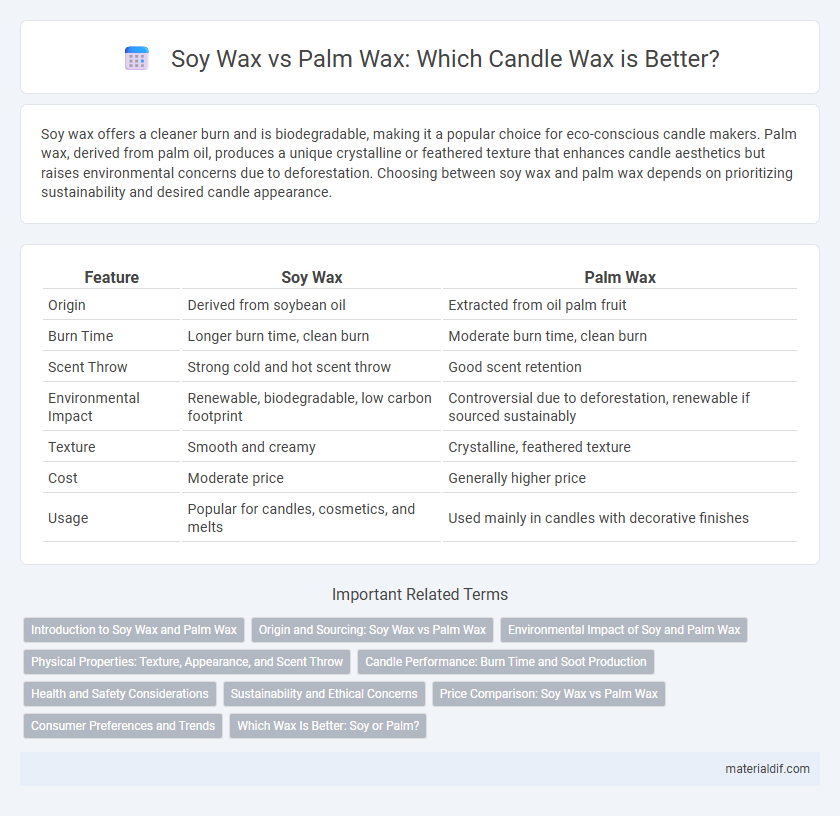Soy wax offers a cleaner burn and is biodegradable, making it a popular choice for eco-conscious candle makers. Palm wax, derived from palm oil, produces a unique crystalline or feathered texture that enhances candle aesthetics but raises environmental concerns due to deforestation. Choosing between soy wax and palm wax depends on prioritizing sustainability and desired candle appearance.
Table of Comparison
| Feature | Soy Wax | Palm Wax |
|---|---|---|
| Origin | Derived from soybean oil | Extracted from oil palm fruit |
| Burn Time | Longer burn time, clean burn | Moderate burn time, clean burn |
| Scent Throw | Strong cold and hot scent throw | Good scent retention |
| Environmental Impact | Renewable, biodegradable, low carbon footprint | Controversial due to deforestation, renewable if sourced sustainably |
| Texture | Smooth and creamy | Crystalline, feathered texture |
| Cost | Moderate price | Generally higher price |
| Usage | Popular for candles, cosmetics, and melts | Used mainly in candles with decorative finishes |
Introduction to Soy Wax and Palm Wax
Soy wax is a natural, biodegradable wax derived from soybean oil, prized for its clean-burning properties and renewable source. Palm wax, extracted from palm oil, offers a crystalline texture and excellent scent retention but raises sustainability concerns due to deforestation. Both waxes serve as eco-friendly alternatives to paraffin, commonly used in candle making and cosmetics.
Origin and Sourcing: Soy Wax vs Palm Wax
Soy wax is derived from the oil extracted from soybeans, predominantly sourced from the United States, Brazil, and Argentina, making it a renewable and biodegradable option. Palm wax originates from the oil of oil palm fruit, primarily cultivated in Indonesia and Malaysia, which raises concerns over deforestation and habitat destruction due to unsustainable farming practices. Sustainable certification programs like RSPO (Roundtable on Sustainable Palm Oil) play a crucial role in promoting responsible sourcing within the palm wax industry.
Environmental Impact of Soy and Palm Wax
Soy wax is biodegradable and derived from renewable soybean crops, resulting in lower carbon emissions and reduced reliance on fossil fuels. Palm wax, while also renewable, often raises environmental concerns due to deforestation, habitat destruction, and biodiversity loss associated with unsustainable palm oil plantations. Choosing certified sustainable sources for both soy and palm wax significantly mitigates their environmental impact, promoting eco-friendly candle production.
Physical Properties: Texture, Appearance, and Scent Throw
Soy wax features a smooth, creamy texture with a natural matte finish, offering a subtle, clean scent throw that enhances fragrance diffusion without overpowering. Palm wax presents a crystalline, textured surface with a glossy appearance, providing a stronger scent throw due to its harder composition that supports higher fragrance loads. Both waxes burn cleanly but differ in tactile and visual qualities, influencing candle aesthetics and scent performance.
Candle Performance: Burn Time and Soot Production
Soy wax offers a longer burn time and cleaner combustion compared to palm wax, resulting in less soot production and a more environmentally friendly candle experience. Palm wax tends to burn faster and may generate more soot due to its higher saturated fat content. Candles made from soy wax are preferred for those seeking durability and reduced indoor air pollution.
Health and Safety Considerations
Soy wax is biodegradable and produces fewer toxins when burned, making it a safer choice for indoor air quality compared to palm wax. Palm wax can contain residual pesticides and may emit higher levels of soot, potentially impacting respiratory health. Both waxes require proper ventilation during candle use to minimize any risks associated with combustion byproducts.
Sustainability and Ethical Concerns
Soy wax is derived from soybean oil, a renewable resource with a lower environmental impact compared to palm wax, which is linked to deforestation and habitat destruction due to palm oil plantations. Soy wax offers better carbon sequestration benefits and supports sustainable farming practices, whereas palm wax production often raises ethical concerns related to biodiversity loss and indigenous land rights. Consumers prioritizing sustainability and ethics tend to prefer soy wax for its transparency in supply chains and reduced ecological footprint.
Price Comparison: Soy Wax vs Palm Wax
Soy wax generally costs more than palm wax due to its renewable soybean supply and labor-intensive production process. Palm wax is often cheaper because of the higher yield per acre and lower processing costs associated with palm oil extraction. Price fluctuations for both waxes are influenced by agricultural factors and global demand for sustainable materials.
Consumer Preferences and Trends
Soy wax is favored by environmentally conscious consumers due to its renewable source, biodegradability, and cleaner burn compared to palm wax, which has raised concerns over deforestation and habitat loss. Trends show rising demand for cruelty-free, sustainable products, driving the popularity of soy wax in candles and cosmetics. However, palm wax remains sought after for its unique crystalline texture and harder finish, appealing to consumers prioritizing aesthetic qualities in wax goods.
Which Wax Is Better: Soy or Palm?
Soy wax offers a cleaner burn and is biodegradable, making it a popular choice for eco-conscious candle makers seeking sustainable ingredients. Palm wax, derived from palm oil, provides a harder texture and unique crystalline patterns, but its production raises significant environmental concerns due to deforestation and habitat loss. Choosing between soy and palm wax depends on prioritizing either environmental impact with soy or aesthetic qualities with palm wax.
Soy wax vs Palm wax Infographic

 materialdif.com
materialdif.com